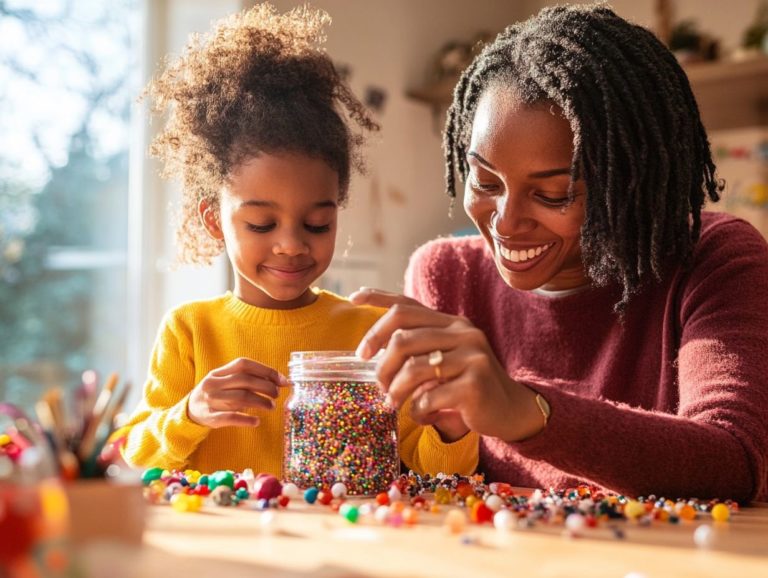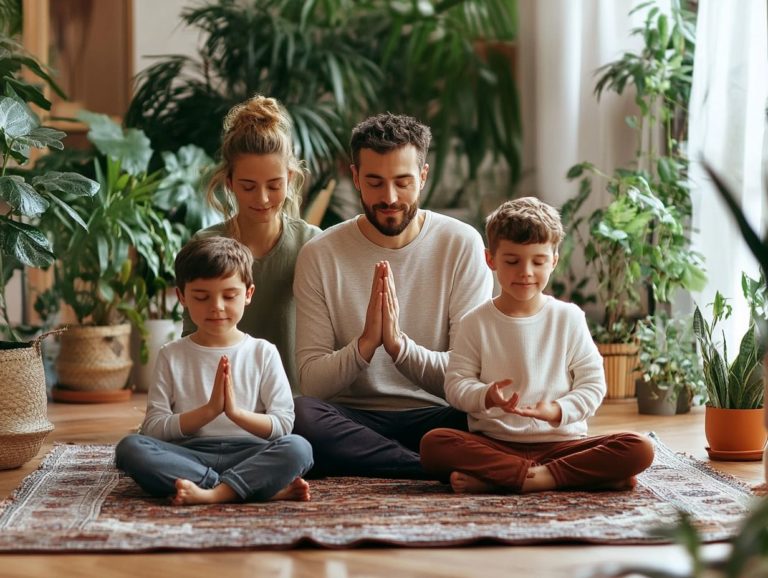Guided Imagery: A Calm Activity for Children
Guided imagery serves as a remarkable tool that taps into the imaginative minds of children, providing them with a tranquil escape while fostering emotional well-being and calm.
This article delves into the essence of guided imagery, explaining how it functions and highlighting its extraordinary benefits, such as alleviating stress and enhancing creativity.
You will find practical tips for conducting guided imagery sessions with children, along with engaging activities designed to ignite their imagination.
This article also addresses potential risks, including sleep anxiety and test anxiety, ensuring you have a comprehensive understanding of this soothing practice.
Dive into the amazing world of guided imagery for children and witness its transformative effects!
Contents
- Key Takeaways:
- What Is Guided Imagery?
- How Does Guided Imagery Work?
- What Are the Benefits of Guided Imagery for Children?
- 4. Promotes Relaxation and Calmness
- How to Use Guided Imagery with Children?
- 1. Find a Quiet and Comfortable Space
- Guided Imagery for Children
- What Are Some Guided Imagery Activities for Children?
- 4. The Space Odyssey
- 5. The Rainbow Journey
- Are There Any Risks of Guided Imagery for Children?
- Frequently Asked Questions
- Understanding Guided Imagery for Children
Key Takeaways:
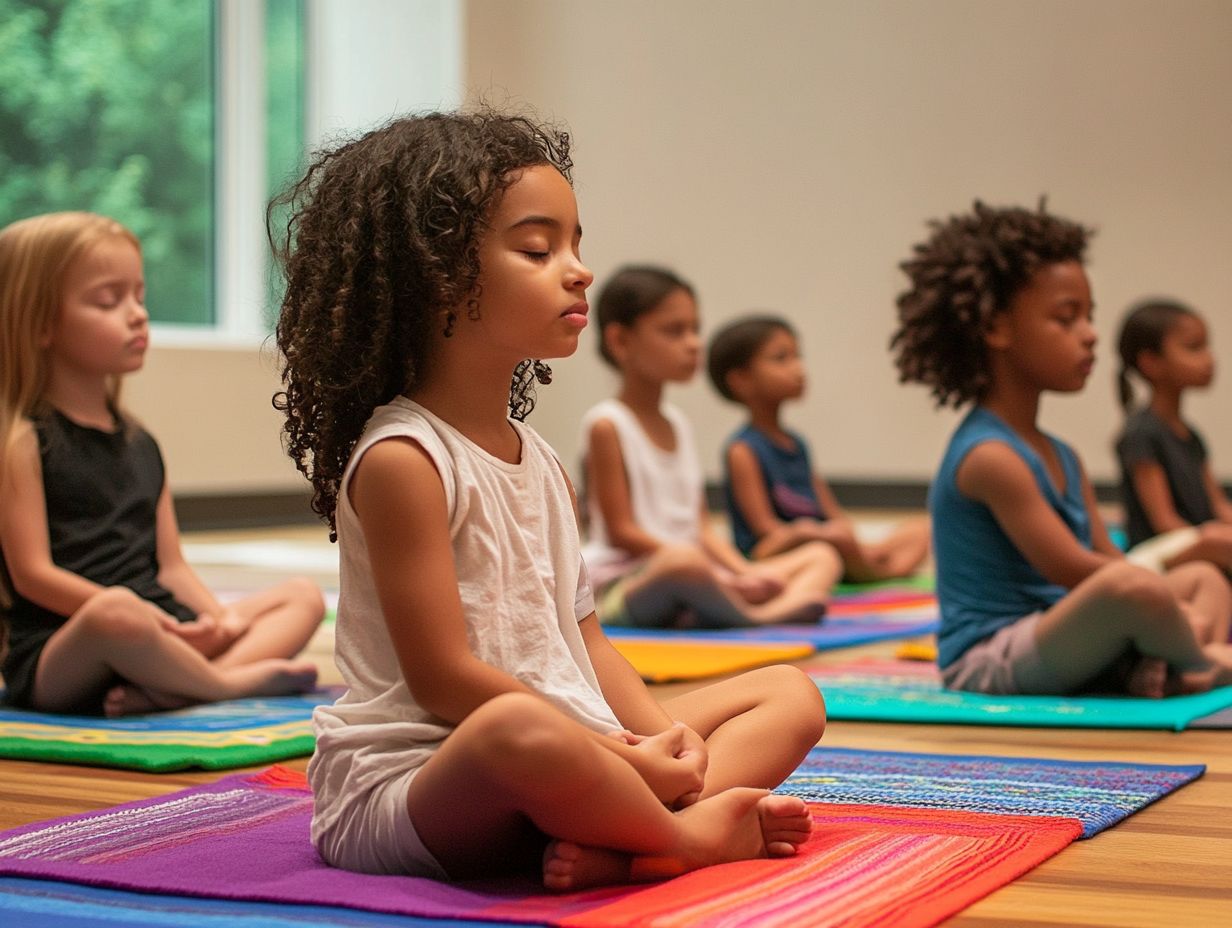
- Guided imagery is a calming activity for children that involves using their imagination to create positive and relaxing mental images, helping to manage stress and anxiety.
- It can help reduce stress and anxiety, enhance creativity and imagination, and improve focus and attention in children.
- To use guided imagery with children, find a quiet and comfortable space, choose a guided imagery script or audio, guide the child through the imagery, and encourage reflection and discussion afterwards.
What Is Guided Imagery?
Guided imagery stands out as a transformative technique that enhances children’s mental health and well-being through the art of visualization and meditation, promoting relaxation. This method is tailored to help children deal with stress and anxiety, while nurturing their creativity and boosting self-esteem. Health professionals and therapists often recommend this technique as part of their therapeutic strategies.
By guiding them to conjure mental images that cultivate a sense of calm, you create a safe haven for exploring their imagination. As health professionals and therapists increasingly champion its benefits, understanding the mechanics of guided imagery equips you with the tools to empower children to master their emotional landscapes with confidence.
How Does Guided Imagery Work?
Guided imagery harnesses the transformative power of visualization, enabling you to create mental images that promote relaxation and emotional healing. By focusing on your breath and following guided instructions, you can transport yourself to a serene and tranquil space, allowing your mind to roam freely through positive thoughts, effectively alleviating stress and anxiety. This technique is well-supported by research showing its effectiveness in managing various emotional challenges.
This technique encourages you to tap into your imagination, crafting personalized mental images that resonate with your unique emotional landscape, ultimately enhancing your overall well-being. Health professionals, including therapists, recommend guided imagery for its numerous benefits, such as reducing stress and anxiety, improving sleep, and boosting overall mental health.
What Are the Benefits of Guided Imagery for Children?
The benefits of guided imagery for children are remarkable, offering advantages that include reducing stress and anxiety, enhancing self-esteem, and fostering creativity and imagination.
This powerful technique serves not only as an effective tool for pain management and test anxiety but also as vital support for overall mental health, promoting relaxation and calmness.
As children immerse themselves in their mental imagery, they gain the ability to confront and understand their emotional states, ultimately leading to improved focus and better academic performance.
Health professionals are increasingly recognizing these benefits, integrating guided imagery into therapeutic strategies for children facing various challenges. According to a study by the Sleep Foundation, guided imagery can also help alleviate sleep anxiety in children.
Start practicing guided imagery today and watch your child’s creativity blossom!
Guided Imagery is an effective technique for children that provides them with powerful tools to reduce stress and anxiety. It equips them with strategies to manage their emotions through visualization and relaxation techniques. This practice encourages children to practice focused breathing and mental imagery, allowing them to create a safe space where they can explore their feelings and cultivate a profound sense of calm.
Health professionals note that regular Guided Imagery helps children develop coping strategies, ultimately enhancing their emotional well-being. Therapists often recommend guided imagery scripts or audio recordings for more effective sessions.
By employing techniques like visualization exercises, children can imagine themselves in peaceful settings whether it s a tranquil beach or a serene forest where they can feel entirely safe and secure. Simple breathing techniques, such as inhaling deeply for a count of four and exhaling for six, empower young individuals to master their physiological responses to anxiety.
Research highlights that these practices not only offer immediate relaxation benefits but also contribute to long-term emotional resilience. Studies suggest that children who consistently engage in Guided Imagery display lower anxiety levels and improved stress management skills, making it an invaluable resource for parents and educators aiming to support emotional development.
2. Enhances Creativity and Imagination
Guided imagery is a remarkable way to enhance creativity and imagination in children. It encourages them to visualize scenarios that foster their creative thinking and problem-solving abilities. This technique engages children’s minds, inviting them to explore unique mental landscapes that stimulate their creativity. Through guided sessions, therapists can support children in tapping into their full creative potential while simultaneously nurturing their emotional well-being. Health professionals often provide free resources to help parents and educators implement this technique effectively.
For example, imagine guiding children to picture themselves as characters in a magical world, where they can soar through the skies or converse with animals. This exercise sparks their imagination and unlocks a world of possibilities, inspiring them to think beyond conventional boundaries.
Guided imagery can also create serene scenes that promote relaxation, assisting children in managing stress and anxiety. By immersing themselves in these vivid visuals, children may experience a boost in self-esteem as they learn to create narratives and solutions that reflect their unique perspectives, ultimately enhancing their emotional health.
3. Improves Focus and Attention
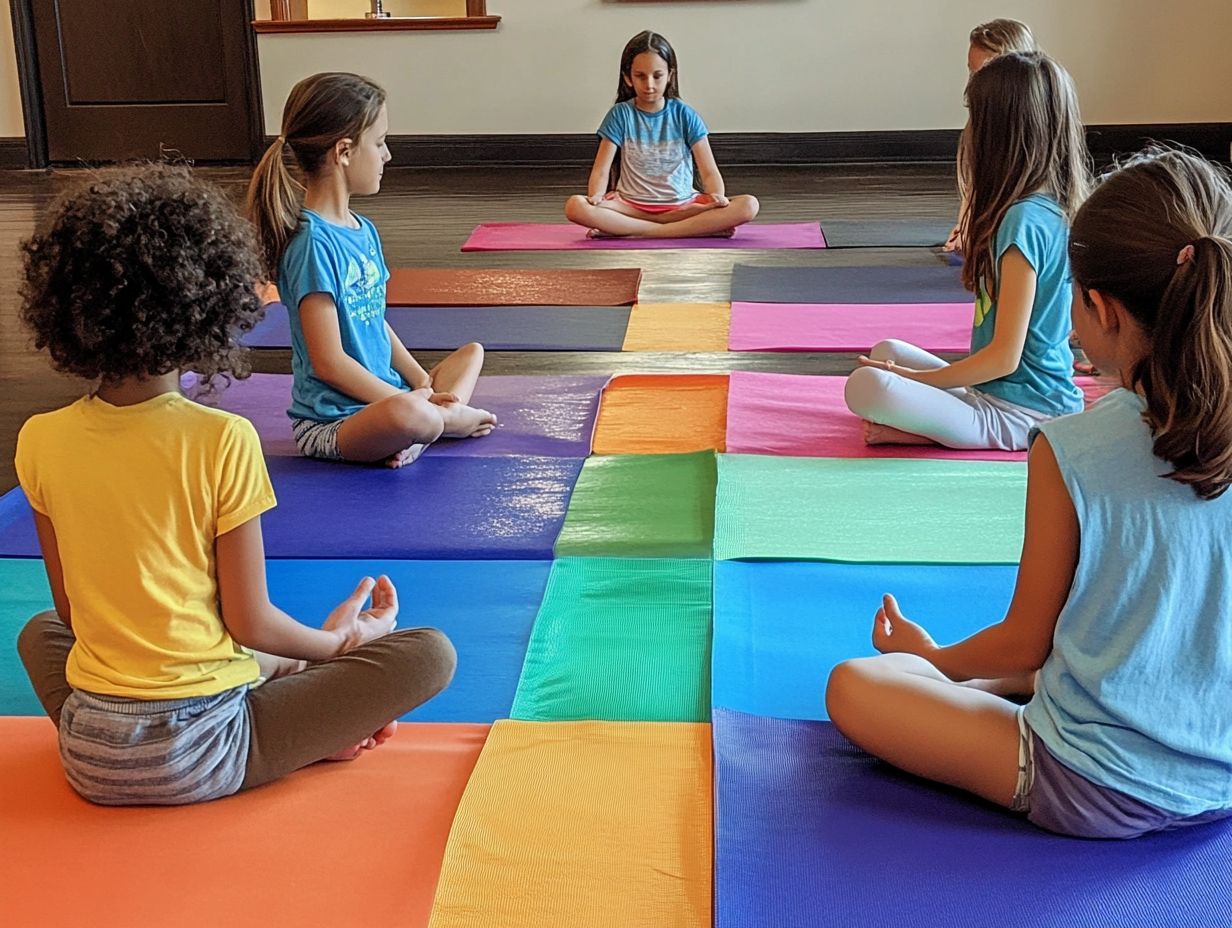
Guided Imagery plays a vital role in enhancing focus and attention in children by providing them with a mental framework for concentration and relaxation. Through visualization techniques, you can help children learn to direct their attention toward specific images or themes, significantly improving their ability to concentrate on tasks and schoolwork. This practice not only calms their minds but also equips them with effective strategies to fend off distractions, ultimately bolstering their academic performance and emotional well-being. Techniques such as focusing on positive thoughts and breathing exercises can further enhance this process.
Integrating these techniques into daily routines can be both effective and enjoyable. Start by setting aside just a few minutes each day for guided imagery sessions, allowing children to close their eyes and visualize a peaceful scene or concentrate on a goal they wish to achieve.
Enhancing these sessions with vivid storytelling can elevate them to the next level. Incorporating reminders like visual cues or quiet moments before homework can facilitate the transition into this focused state, enabling children to channel their improved concentration into learning activities.
By nurturing a consistent practice, you can help them gradually enhance their attention span and academic outcomes. Make these guided imagery sessions part of your daily routine today to see amazing improvements in your child’s focus!
4. Promotes Relaxation and Calmness
Guided Imagery invites you to promote relaxation and calmness in children by employing visualization and breathing exercises to conjure serene mental landscapes. By engaging in this practice, children can escape the hustle and bustle of daily life, offering them a mental retreat that alleviates feelings of stress and anxiety. This soothing experience is vital for their mental health, enabling them to feel grounded and centered.
Incorporating elements of nature, such as imagining a peaceful beach or forest, can enhance the relaxation experience. To effectively implement Guided Imagery at home or during therapy sessions, encourage children to close their eyes and take deep, slow breaths to initiate the process.
Guide them to imagine a favorite place, like a beach or a forest, where they can vividly visualize details perhaps the sound of waves lapping at the shore or the scent of pine trees wafting through the air. This practice helps children manage negative thoughts and improve their overall emotional health.
Creating the right environment is essential; dim lighting, comfortable seating, and calming music can significantly enhance the experience. Remind children to take their time, allowing the imagery to unfold at their own pace. This approach deepens their sense of relaxation and safety, making the journey all the more impactful. A quiet environment is crucial for maximizing the benefits of this practice.
How to Use Guided Imagery with Children?
Using Guided Imagery with children can be an exciting adventure, and you can enhance its effectiveness by adhering to some straightforward guidelines.
Establishing a tranquil environment is crucial; this serene setting fosters focus, enabling children to immerse themselves in their mental imagery. Selecting suitable guided imagery scripts or audio recordings can significantly enrich the experience, allowing children to tap into their emotions and envision uplifting scenarios.
Research suggests that consistent practice of guided imagery leads to long-term improvements in children’s emotional state and overall well-being. After the session, prompting reflection and discussion encourages children to articulate their experiences, thereby solidifying the benefits of this impactful technique.
Utilizing tools like vivid storytelling and visual cues can further enhance their ability to connect with their mental images and emotional state.
1. Find a Quiet and Comfortable Space
Ensuring a quiet and comfortable space is critical for effective guided imagery sessions, as it helps create the ideal environment for children to focus on their mental images and tap into their imagination.
When practicing Guided Imagery with children, finding a quiet and comfortable space is essential. It sets the stage for relaxation and focus, allowing them to fully immerse themselves in their visualization and meditation.
In a tranquil environment, distractions fade away, enabling children to explore their mental images without interruption. This space should feel inviting and calming, promoting a sense of security and comfort.
You can create such a space by choosing a room with soft lighting and cozy seating think cushions and blankets that invite them to snuggle in. To minimize ambient noise, consider shutting windows or using white noise machines to create a soothing sound barrier.
Incorporating gentle music or nature sounds can further enhance the atmosphere, making it ideal for guided imagery and meditation. Establishing a routine for these sessions is also beneficial, as consistency helps children adapt to and look forward to their Guided Imagery experiences.
Allowing them to personalize their space with items that make them feel safe, such as favorite toys, cherished pictures, or calming scents, can significantly elevate their comfort level and enhance their mental health.
Guided Imagery for Children
2. Choose a Guided Imagery Script or Audio Recordings
Choosing a guided imagery script or audio recording specifically designed for children can greatly enhance their engagement with the technique. These resources offer structured guidance that helps children effectively navigate their visualization journey.
Fostering a deeper connection with their mental images and emotions is key. When you select age-appropriate and relatable content, you ensure that the imagery resonates with the child, encouraging them to explore their emotions more freely.
As you consider suitable guided imagery options, it s important to take into account the child’s developmental stage and specific emotional needs. For example, scripts that incorporate themes from popular children’s books or beloved characters can capture their attention and make the experience more enjoyable, promoting self-esteem and creativity.
Resources like “Imagery for the Young” by Nancy L. Faber or various audio offerings available on platforms like YouTube address a range of scenarios, such as relaxation, confidence-building, or coping strategies for anxiety and stress.
These tools can be tailored for different age groups, from preschoolers who thrive on simple fairy tales to older children who benefit from more complex narratives that promote self-reflection and pain management. By selecting the right material, you can create engaging and meaningful experiences that empower children to better understand their feelings.
3. Guide the Child through the Imagery
Leading your child through the imagery process is crucial for success in a Guided Imagery session, ensuring they feel supported and engaged throughout the experience. As the guide, whether you’re a therapist or a parent, you can offer gentle prompts and cues that help the child visualize specific scenes, encouraging them to fully immerse themselves in their imagination.
This supportive approach fosters a sense of safety and trust, allowing your child to relax and explore their mental images and emotions freely. Effective guiding techniques play a crucial role in enhancing this experience.
Your voice should be calm and soothing, creating a peaceful atmosphere that promotes relaxation. Consider the pacing of the session carefully; a slower pace allows your child the time to fully process and visualize the imagery. Remain attentive to their words and nonverbal cues, adjusting your approach as needed. Using tools and techniques tailored to the child’s needs can also be beneficial.
For instance, if your child appears anxious, offering words of encouragement and reassurance can help redirect their focus back to a positive imagery experience, ensuring that the session remains both beneficial and enjoyable.
4. Encourage Reflection and Discussion
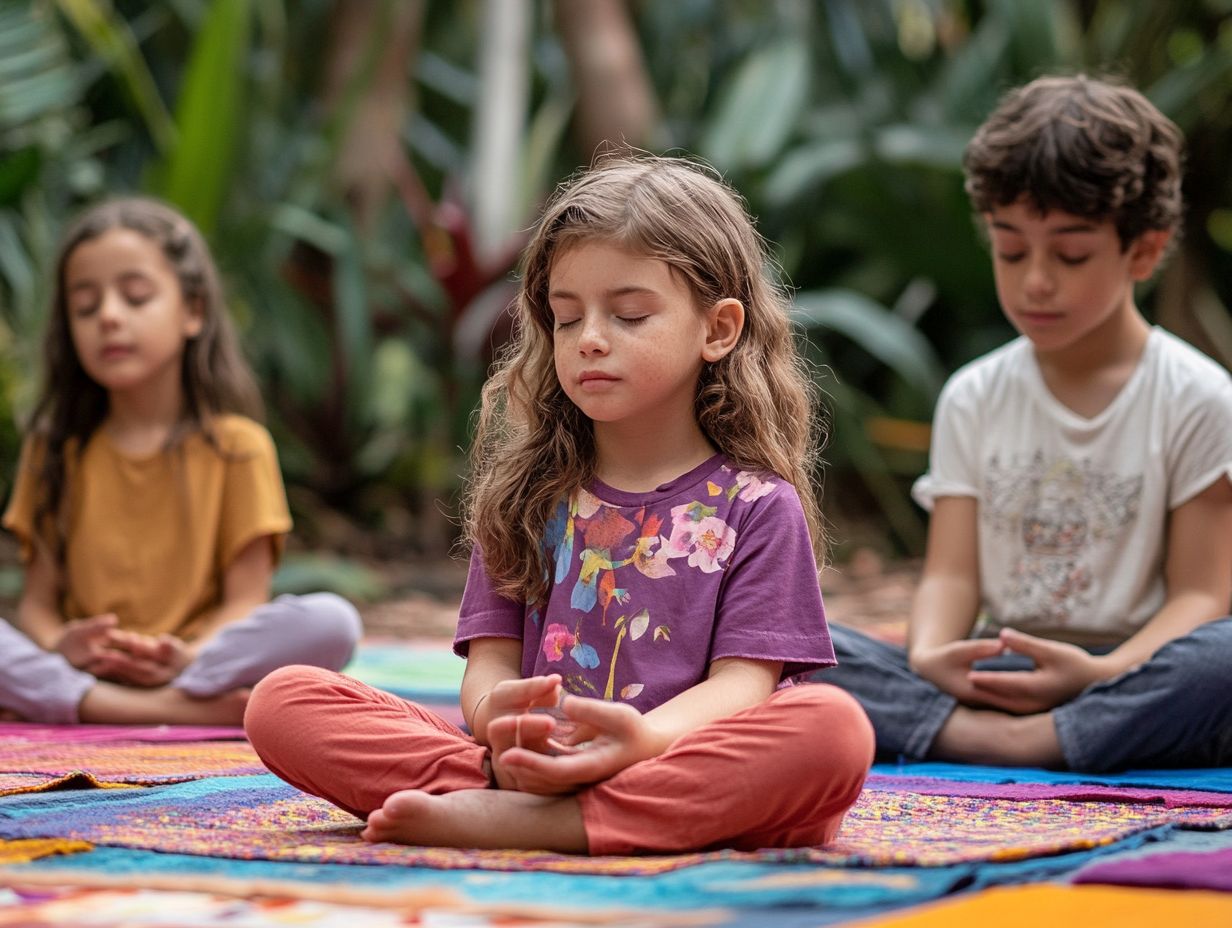
Encouraging reflection and discussion after a Guided Imagery session is essential, as it allows children to process their experiences and articulate their emotional states. Engaging in conversations about the imagery enables them to connect their mental images with real-life feelings and situations, thereby reinforcing the practice’s benefits.
This dialogue not only sheds light on their emotional well-being but also fosters a deeper understanding of their thoughts and feelings, aiding in emotional regulation.
Facilitating these conversations creates a safe environment for children to share their insights, playing a crucial role in enhancing their emotional intelligence. To guide the discussion effectively, consider asking open-ended questions such as:
- “What did you feel when you imagined that scene?”
- “Can you describe what you saw?”
These prompts encourage them to delve deeper into their emotions and make connections between their imaginative experiences and everyday life. Inviting them to reflect on how they might apply any lessons learned in their daily interactions can further enrich their emotional understanding and facilitate their growth.
Research shows that such reflections are critical for mental health and emotional well-being. Try these techniques today and watch your child blossom emotionally!
What Are Some Guided Imagery Activities for Children?
Guided Imagery activities for children offer an engaging and imaginative approach to using the power of imagination in a delightful and creative way. These activities, supported by studies, help manage stress and anxiety while promoting better mental health.
Through these activities, your child can explore their mental landscapes, nurturing creativity and promoting relaxation and emotional well-being.
By engaging in structured Guided Imagery activities, your child can cultivate effective coping strategies for stress and anxiety, ultimately enhancing their overall mental health in a joyful manner.
1. The Magic Garden
The Magic Garden is a captivating Guided Imagery activity that invites children to visualize a beautiful and serene garden brimming with enchanting plants, flowers, and delightful creatures. This activity encourages exploration of the imagination and creates a personal oasis of relaxation and calm.
As they wander through their magical garden, children can focus on intricate details and sensations, promoting mindfulness and emotional well-being. Techniques like this are invaluable tools in stress management.
To embark on this enriching journey, find a quiet space where your child can sit comfortably and close their eyes. Start by taking a few deep breaths, inhaling the calming scents of the imagined garden. As the guided imagery unfolds, allow them to visualize vibrant colors, hear the soothing sounds of nature, and feel the gentle breeze brushing against their skin.
Consider prompts like, “What adventures await you in your magical space?” or “What types of flowers are blooming in your garden?” to deepen engagement. The benefits of this activity are plentiful; it can significantly reduce stress, enhance creativity, and encourage emotional expression, fostering a sense of peace and serenity that they can carry throughout their day.
2. The Ocean Adventure
The Ocean Adventure Guided Imagery activity invites children to immerse themselves in a vibrant underwater world, filled with colorful sea life and the gentle rhythm of ocean waves. This captivating experience nurtures creativity while providing a serene escape from everyday stresses.
As they set sail on their ocean adventure, children engage their senses, fostering a profound sense of tranquility and joy. To kick things off, invite them to close their eyes and take deep breaths, guiding them to tune into the soothing sound of waves softly lapping against the shore. They can envision the salty breeze caressing their skin and the warm sunlight shimmering through the water’s surface.
With gentle prompts, encourage them to picture themselves swimming alongside playful dolphins or marveling at schools of lively fish darting around vibrant coral reefs. This sensory engagement ignites their imagination and nurtures mindfulness, allowing them to develop emotional resilience.
The soothing effects of this imaginative journey can help reduce anxiety, enhancing their overall sense of well-being and making it an invaluable tool for emotional regulation.
3. The Enchanted Forest
The Enchanted Forest Guided Imagery activity invites children to visualize a magical forest brimming with wondrous creatures and enchanting sights. This journey through the forest serves as a delightful escape, promoting relaxation and emotional well-being.
To embark on this imaginative journey, start by closing your eyes and taking a deep breath. Picture the lush greenery and vibrant colors enveloping you as you step into the forest. Consider prompts like, “What sounds do you hear as you walk through the trees?” or “What kind of animals might you encounter on your adventure?” These questions stimulate creativity and invite reflection on perceptions and feelings.
As they envision stepping over a babbling brook or discovering a hidden glade, children cultivate mindfulness, gently soothing any anxieties that may arise. This activity enhances imaginative capacity and creates a safe space for self-expression and emotional exploration.
4. The Space Odyssey
The Space Odyssey Guided Imagery activity invites you to transport children into the boundless expanse of space, where they can vividly visualize their journey among stars, planets, and galaxies. This imaginative exploration allows them to expand their creativity while fostering a sense of awe and wonder at the universe.
As they embark on this cosmic adventure, they’ll experience relaxation and joy. This activity boosts creativity and serves as a powerful tool for stress relief, helping children feel calm and balanced.
Begin the process by creating a cozy environment where they can settle in comfortably preferably lying down or sitting back and closing their eyes while taking deep breaths. Enhance their experience with sensory prompts like soft instrumental music or ambient space sounds, igniting their imaginations even further. Encourage them to envision the warmth of a distant sun on their skin or the refreshing coolness of the vacuum of space as they float among celestial bodies.
This activity allows young minds to disconnect and find tranquility in the infinite wonders of the cosmos.
5. The Rainbow Journey
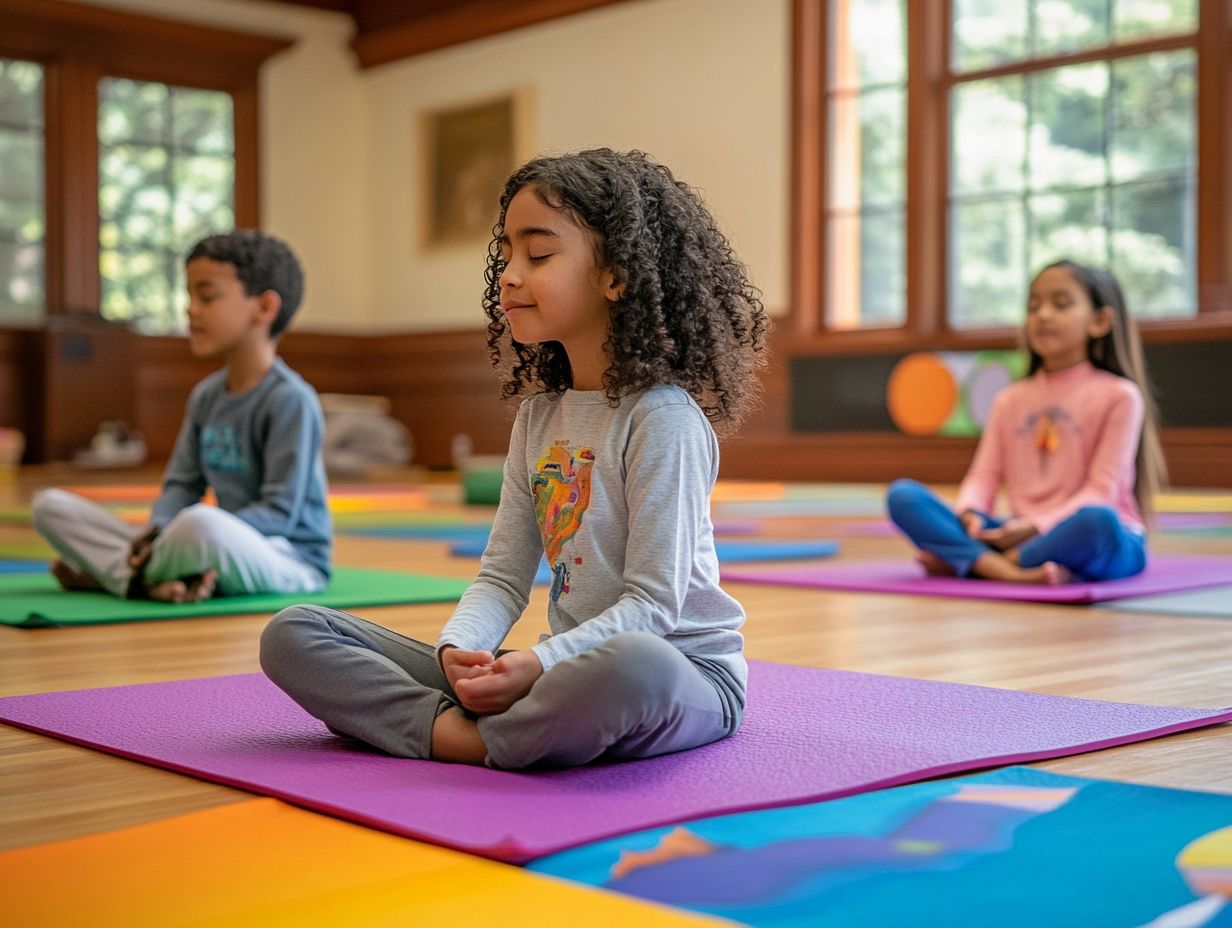
Get ready to explore your feelings and dreams in this uplifting experience! The Rainbow Journey Guided Imagery activity invites you to embark on a vibrant adventure across a colorful rainbow, a powerful symbol of hope and positivity. This uplifting experience encourages you to explore your feelings and aspirations while promoting relaxation and emotional wellness.
To facilitate this transformative experience, start by creating a calm and comfortable environment where you feel safe to express yourself. Close your eyes and take deep breaths, allowing any tension to melt away.
Now, imagine each color of the rainbow representing different emotions or aspirations:
- Red for courage
- Orange for creativity
- Yellow for happiness
- Green for growth
- Blue for calm
Visualize yourself stepping onto the rainbow, taking note of what you see, hear, and feel during your journey.
After your visualization, reflect on your experience with questions like, “How did the colors make you feel?” or “What dreams did you discover on your journey?” This activity not only nurtures your emotional health but also cultivates a positive mindset, giving you the power to express your emotions in a constructive manner.
Are There Any Risks of Guided Imagery for Children?
Guided Imagery is a powerful tool for children’s mental health, but it’s vital for both parents and therapists to recognize the potential risks that can accompany its practice.
Some children might encounter discomfort or heightened anxiety when facing certain mental images or looking into challenging emotions during guided sessions. Approaching Guided Imagery with a sense of sensitivity is crucial, as ensuring the child feels comfortable and supported throughout the process can significantly help mitigate any negative responses.
Frequently Asked Questions
What is guided imagery and how does it benefit children?
Guided imagery is a relaxation technique that involves using visualizations and imagination to create a peaceful and calm state of mind. It can benefit children by reducing stress and anxiety, improving focus and concentration, and promoting overall emotional well-being.
How does guided imagery work?
Guided imagery works by using the power of the mind to create a peaceful and positive state of being. By visualizing calming images and scenarios, children can enter a relaxed state and experience a sense of inner peace and tranquility.
Can guided imagery be used as a coping mechanism for children?
Yes, guided imagery can be a helpful coping mechanism for children. It can provide them with a sense of control and relaxation during difficult or stressful situations. It can also help them process and manage their emotions in a healthy way.
How can I introduce guided imagery to my child?
You can introduce guided imagery to your child by finding a quiet and comfortable space, and guiding them through a relaxation exercise using calming language and visualization prompts. There are also many guided imagery resources and apps available for children.
Start this enriching journey today and watch your child’s creativity and emotional well-being flourish!
Understanding Guided Imagery for Children
Is guided imagery safe for all children?
Guided imagery is generally safe for children! However, it may not be suitable for those with certain mental health conditions. Always consult a healthcare professional before starting any new relaxation practice with your child.
Can guided imagery be used as a bedtime routine for children?
Absolutely! Guided imagery can be a fantastic addition to a bedtime routine. It helps children wind down and relax, making way for a peaceful night s sleep.

